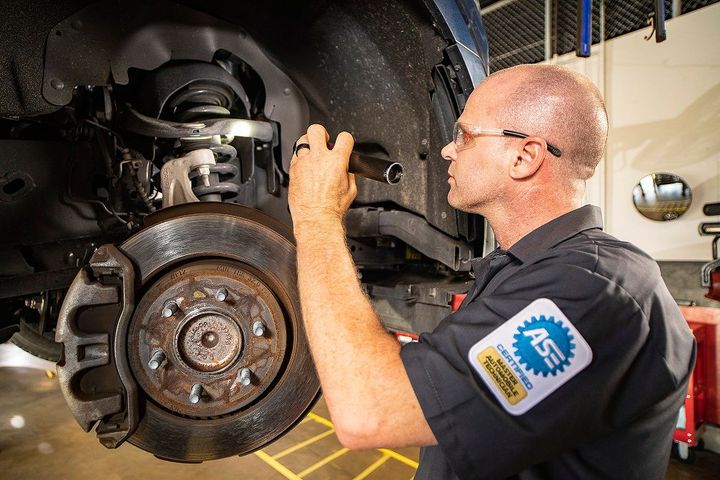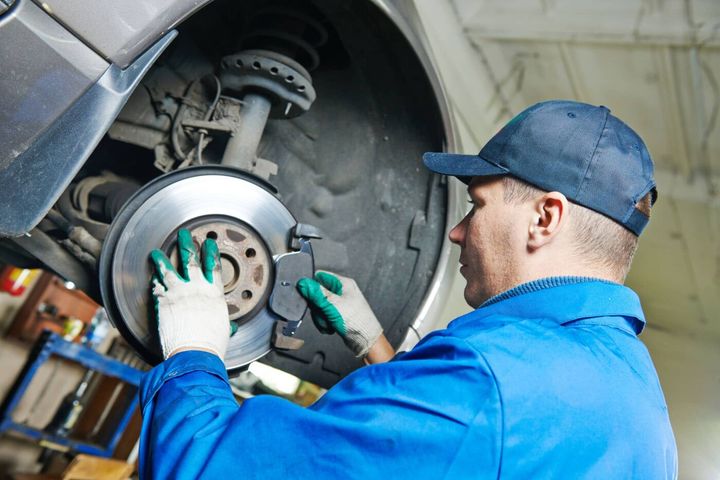


Braking is a critical skill for safe driving, yet many drivers struggle to bring their vehicles to a smooth and controlled stop. Abrupt or jerky braking can lead to discomfort for passengers, potential loss of control, and increased wear on the vehicle's components. Mastering the art of smooth braking not only enhances the driving experience but also contributes to overall safety on the road.

The inability to come to a complete stop can be attributed to several factors, primarily related to the braking system, clutch, transmission, or engine. Let's delve into these potential culprits:
The braking system is often the first suspect when a vehicle has trouble stopping. Here are some common brake-related issues:
| Issue | Description |
|---|---|
| Worn Brake Pads or Shoes | Over time, the friction material on brake pads or shoes can wear down, reducing their ability to generate enough friction to stop the vehicle effectively. |
| Air in the Brake Lines | Air trapped in the brake lines can significantly reduce hydraulic pressure, leading to a spongy or ineffective brake pedal. |
| Leaking Brake Fluid | A leak in the brake fluid system can cause brake fade or even complete failure, as the fluid level drops and air enters the lines. |
| Stuck or Frozen Brake Calipers | If a brake caliper becomes stuck or frozen, it can prevent the brake pads from releasing properly, causing excessive drag and difficulty stopping. |
For vehicles with manual transmissions, clutch issues can also contribute to stopping difficulties:
Worn Clutch Disc: A worn or damaged clutch disc may not fully disengage the engine from the transmission, causing the vehicle to continue moving even when the clutch pedal is depressed.
Clutch Hydraulics Issues: Leaks or air in the clutch hydraulic system can prevent the clutch from disengaging properly.
The transmission plays a crucial role in transferring power from the engine to the wheels. Problems here can affect stopping ability:
Slipping Transmission: If the transmission is slipping or not transferring power effectively, it can cause the vehicle to continue moving even when the brakes are applied.
Low or Contaminated Transmission Fluid: Insufficient or contaminated transmission fluid can lead to improper operation and slippage.
In some cases, engine issues can also contribute to stopping difficulties:
Engine Stalling: If the engine stalls due to faulty sensors, fuel system faults, or ignition problems, it can cause the vehicle to lose power and momentum, making it harder to stop.
When faced with a vehicle that has trouble coming to a complete stop, there are several troubleshooting steps I recommend:
Listen for Abnormal Noises: Pay attention to any unusual noises, such as grinding, squealing, or knocking, when applying the brakes. These can indicate worn brake components or other issues.
Check Brake Pedal Feel: The brake pedal should feel firm and responsive. If it feels spongy or goes all the way to the floor, it could indicate air in the brake lines or a more serious problem.
Inspect Clutch Pedal Engagement (Manual Transmission): For manual transmissions, check if the clutch pedal engages and releases smoothly. Any issues here can contribute to stopping difficulties.
Look for Brake Fluid Leaks: Inspect around the brake calipers, lines, and master cylinder for any signs of brake fluid leaks, which can cause brake failure.
Check Transmission Fluid Level and Condition: Low or contaminated transmission fluid can lead to slippage and affect the vehicle's ability to stop.
Use an OBD2 Scanner: Connect an OBD2 scanner to check for any trouble codes related to the braking, transmission, or engine systems. These codes can provide valuable diagnostic information.
Once the root cause of the stopping issue has been identified, appropriate repairs can be undertaken. Here's a detailed overview of common repair procedures:
| Repair | Description |
|---|---|
| Brake Pad/Shoe Replacement | If the brake pads or shoes are worn, they should be replaced, and the rotors or drums may need resurfacing or replacement as well. This involves removing the old pads/shoes, inspecting and resurfacing or replacing the rotors/drums if necessary, and installing new pads/shoes. |
| Brake Line Bleeding | If air is present in the brake lines, the system should be properly bled to restore full hydraulic pressure. This process involves opening the bleed valves and pumping the brake pedal to force the air out of the lines and replace it with fresh brake fluid. |
| Brake Component Replacement | Leaking or faulty brake components, such as calipers, lines, or the master cylinder, may need to be replaced. This involves removing the old component, installing a new one, and bleeding the system to ensure proper operation. |
Clutch Disc and Component Replacement: For a worn clutch disc, the entire clutch assembly, including the pressure plate and associated components, may need to be replaced. This involves removing the transmission, disassembling the clutch components, and installing new parts.
Clutch Hydraulic System Bleeding: If the clutch hydraulic system has air or leaks, it should be bled or repaired as necessary. This process involves opening the bleed valve and pumping the clutch pedal to force the air out and replace it with fresh fluid.
Transmission Fluid Change: Draining and refilling the transmission fluid, along with replacing the filter, can help address issues related to low or contaminated fluid. This involves removing the old fluid, replacing the filter, and refilling the transmission with fresh fluid.
Transmission Component Repair or Replacement: Faulty transmission components, such as solenoids or clutch packs, may need to be repaired or replaced to resolve slippage or other issues. This can involve disassembling the transmission, inspecting and replacing faulty components, and reassembling it.
Engine Diagnosis and Repair: If the engine is stalling or experiencing other issues, a thorough diagnosis should be performed, and necessary repairs should be carried out based on the trouble codes and symptoms. This can involve inspecting and replacing faulty sensors, fuel system components, ignition system parts, or other engine components as needed.
While repairs can address the immediate problem, it's essential to take preventive measures to avoid future occurrences of stopping difficulties:

Follow Recommended Service Intervals: Adhering to the manufacturer's recommended service intervals for brake, clutch, and transmission system inspections and maintenance can help identify and address potential issues before they become major problems.
Check Fluid Levels Regularly: Make it a habit to regularly check and top up fluid levels for the brake, clutch, and transmission systems as needed.
Avoid Aggressive Driving: Aggressive driving habits, such as sudden braking or rapid acceleration, can accelerate wear on these critical components.
Proper Clutch Technique (Manual Transmissions): For manual transmission vehicles, using proper clutch technique when starting and stopping can help extend the life of the clutch components.
The cost of repairs can vary significantly depending on the root cause and the extent of the work required. Here are some general cost estimates:
| Repair | Cost Range |
|---|---|
| Brake Pad/Shoe Replacement | $100 to $300 per axle |
| Brake Caliper or Line Replacement | $200 to $500 or more per component |
| Clutch Replacement | $500 to $1,500 for parts and labor |
| Transmission Repairs | $1,000 to $3,500 or more, depending on the issue |
| Engine Repairs | $500 to $5,000 or more, depending on the components involved |
It's crucial to have a professional mechanic properly diagnose the issue to determine the right repair approach and provide an accurate cost estimate.
Trouble coming to a complete stop is a serious issue that should not be ignored. As a mechanic, I've seen firsthand the potential dangers and consequences of neglecting this problem. By understanding the potential causes, following proper troubleshooting steps, and addressing the underlying issues through appropriate repairs and preventive measures, you can ensure the safety of yourself and others on the road.
Regular maintenance and responsible driving habits can go a long way in preventing stopping difficulties and extending the life of your vehicle's critical components. Don't hesitate to seek professional assistance if you encounter any issues with your vehicle's stopping ability, as it's a matter of safety for you and those around you.
If the brake system warning light remains illuminated, it indicates a potential issue with the braking system. You should have the vehicle inspected by a qualified technician as soon as possible.
To check for current warnings, select "Warning Guidance" in the multi-information display to view any active warnings.
If a message indicates the shift lever is not in the P (Park) position when trying to start the engine, you need to shift the transmission to Park before restarting.
The seatbelt warning displays if a seatbelt is unfastened and the driver's door is opened while the i-stop (engine auto stop/start) function is active.
If instructed to depress the brake pedal, you need to press down on the brake pedal fully before attempting to start the engine.
A message about the clutch pedal means you need to depress the clutch pedal fully before trying to start the engine on a manual transmission vehicle.
A steering wheel lock message displays if the steering wheel is locked when you try to start the engine. You need to release the steering lock before restarting.
If a warning light flashes, you should check the multi-information display for the specific warning message and take the recommended action.
To find more information about a displayed warning light or symbol, you can search for details on that specific warning in the owner's manual.
If you cannot determine the cause of a warning message or light after checking the owner's manual, you should have the vehicle inspected by a qualified technician.

Sarah isn't your average gearhead. With a double major in Mechanical Engineering and Automotive Technology, she dived straight into the world of car repair. After 15 years of turning wrenches at dealerships and independent shops, Sarah joined MICDOT to share her expertise and passion for making cars run like new. Her in-depth knowledge and knack for explaining complex issues in simple terms make her a valuable asset to our team.












